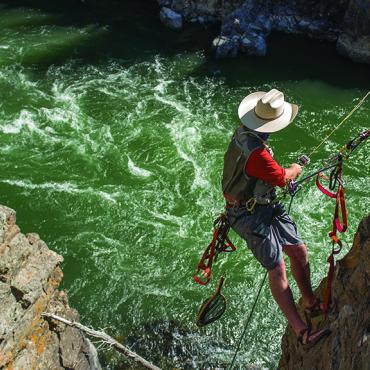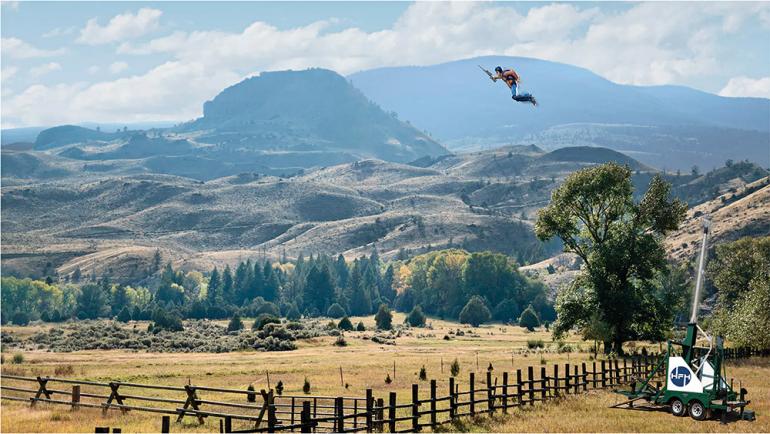Uncharted Territory
A new vision for public-land access.
Much has been written about the abundance of huntable land Montana has to offer, but little is known of the hundreds of public parcels sitting in isolation. Historically, setting foot on them has been limited to the ranchers and wealthy landowners who own the surrounding acreage. Until now, that is.
Bozeman start-up Hucking for Hunters (HFH) may solve this problem once and for all, with its patented ballistic device, the Huckster. Grant S. Axes, HFH owner and founder, came up with the idea of a human catapult while hunting elk in the Crazies. “I had a huge bull standing broadside on Forest Service land, with no way to get to him,” Axes says. A narrow strip of private land separated his position on the trail from the public land beyond. Axes shakes his head, recalling his frustration. “He was only 100 yards away, but he may as well have been on Turner’s.”
That night, Axes returned home in a fury and turned on Gladiator to decompress. “Not five minutes into the first battle scene, I knew what I needed to do,” he remembers. Axes, a graduate of the MSU architecture program, began designing the first Huckster the next day.
The contraption is modeled after ancient Roman catapults, and while the design is much the same, the application is far more nuanced. Axes infused technology derived from county land surveys, OnX Maps, and a Chinese company that hacks Elon Musk’s satellites into a GPS device capable of determining landing location down to the nearest foot. “Apart from all the AI involved, there’s really nothing to it,” Axes says casually. “Think of it as a self-driving car, only you’re 200 feet in the air. And you’re carrying a gun. Pretty sweet, right?”
The first successful launch was in Fergus County in 2019. Axes sailed a quarter-mile onto a piece of otherwise-inaccessible school-trust land and harvested one of the biggest bucks of his life. Though not typically one to reveal hunting spots or brag about success, Axes saw this as an opportunity. He posted photos and video using geolocation across all his platforms. Overnight, he turned into a social-media icon. “Stick it to the man,” one comment read. “Justice for Montanans! Axes for President!” said another. Within a few days, #huckoff and #giveahuck were among the most popular hashtags on Twitter. Soon thereafter, bumper stickers began appearing in Bob Ward’s and Sportsman’s Warehouse parking lots, bearing the words “Huck the Rich” and “The Flying D Must Now Contend with Flying Me.” Axes himself became known as “the Incredible Huck.”
“At that point, I knew I was onto something,” he explains. “And it was bigger than myself. This was something that could change public-land hunting forever.”
Over the winter, Axes and his friends worked nonstop, building 20 Hucksters in just three months. “Of course there were some hurdles,” he admits. “For starters, initial models could only huck up to 200 pounds, and the majority of our customer base was well over 250. We had to pivot.” The hold-up didn’t last for long, though. Once they were able to supply a little more muscle power, Hucksters were hurtling out of the factory left and right. The 2021 roll-out even includes an ultralight model—the HuckLite—made of carbon fiber, graphene, and cheesecloth, which in a pinch can be removed to serve as impromptu game bags. HuckLites are designed for the backcountry hunter who’s looking to access landlocked sections of state and federal land that sit several miles from the nearest trailhead. The HuckLite collapses to fit inside a 65-liter pack and can be assembled on-site in five minutes. “It’s perfect for a quick corner-crossing,” Axes says.
On the other end of the product line, the BubbaHucker can send up to 400 pounds over a full section of open ground. Unlike the HuckLite, which is popular with locals, most BubbaHucker orders come from south of the Mason Dixon line, and Billings. The downside: it mounts on its own trailer and requires a one-ton pickup to transport it. But according to Axes, that obstacle hasn’t slowed down orders. “Most Bubbas—I mean, BubbaHucker customers—already own an F-350 or Dodge Dually,” he says.
One of the main questions HFH gets is this: How dangerous is it to catapult over private land? And what kind of experience does one need? “As far as the catapults themselves go, they really are user-friendly,” Axes says. “You punch in the coordinates and after launch, wait for the parachute to deploy. Simple as that.” According to Axes, angry landowners may be the biggest thing to fear. “I’d be lying if I said I haven’t had a couple scary hucks,” he recalls. “You gotta know whose ground you’re flying over. Not because it’s illegal, but because some of those crazy bastards might take a shot at you. You’d be surprised at the lengths private landowners will go to protect their public land.”
While Hucksters are surging in popularity like man-buns in downtown Bozeman, not everyone’s onboard. Belgrade resident, Army veteran, and central Montana road-hunter Skip T. Scism thinks that this is the opposite direction hunting should take. “One morning, I saw 10 of these boys dropping in on one 500-acre parcel,” the 95-year-old Scism says. “It reminded me of D-Day. And I don’t mean the old Gardiner late hunt at Deckard Flats.”
When asked, Axes attributes this concentration to the fact that all first-timers must be supervised at a designated launch site. “We only have a few spots right now, but demand is high. We’re trying to focus on the biggest assholes first,” he says, pointing out that all official training locations currently surround the Wilks brothers’ ranches.
While the debate rages on, one thing’s for certain: Hucking for Hunters isn’t slowing down. “I mean, some of these areas haven’t been accessed for decades,” Axes says. “In a way, it’s like rediscovering the West.”
For more information, visit huckingforhunters.com.













